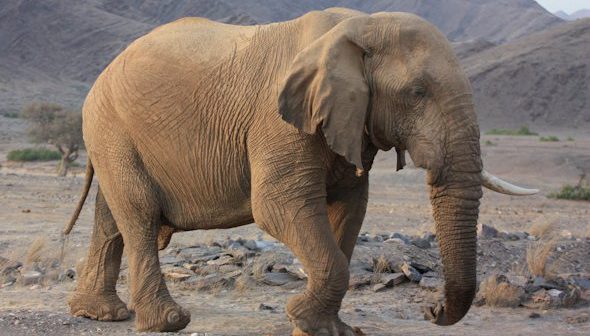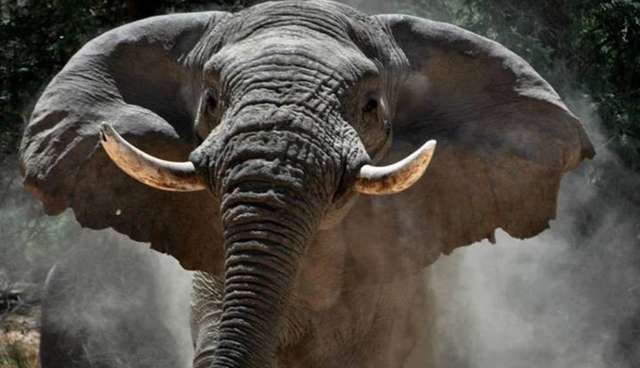
Namibia’s desert elephants back on the butcher’s block
BY LOUZEL LOMBARD STEYN - 30 AUGUST 2017 - TRAVELLER24
Three of Namibia’s iconic desert elephants have become moving targets after the Ministry of Environment & Tourism (MET) earlier this month approved permits to hunt them. The hunting permits – one problem bull tag and two trophy bull tags – have been issued for the Ugab basin where the iconic ‘Voortrekker’ bull also roams.
The Lawrence Anthony Earth Organization states that MET should at least produce the problem animal’s rap sheet – which shows its destructive track record – before a decision is made for it to be killed.
MET have not responded to any queries for the rap sheet of the problem elephant and according to an online petition by Desert Elephants & Friends “no alternatives were taken into consideration. It will just be shot.”
Elephants in the Ugab region have been hunted under a ‘problem elephant’ excuse before. According to the Earth Organization Namibia, MET may in its discretion declare any wild animal a ‘problem animal’, without any specific legal procedure to make this determination. “All the power sits with MET, with no checking mechanism,” Earth Organization Namibia says.
Even though it should be standard procedure to implement the Precautionary Principal to ensure the sustainability of endangered species, MET is turning a blind eye to their own Environmental Management Act. During the Great Elephant Census (GEC), published last year Namibia elected not to have its elephants counted according to international standards, free of charge. Instead it argued at the 2016 Convention on International Trade in Endangered Species (CITES) that it needed special permission to trade in ivory, claiming steady growing elephant populations.
For the trophy hunts, issuance of these hunting permits isn’t a new phenomenon either. The Namibian Government has been and is still granting hunting permits for elephants despite public outcry and the obvious questionability of killing elephants for sport from already low and declining populations.
Desert elephants are even advertised as ‘some of the rarest animals in the world’, considerably upping the bounty on their heads, Desert Elephants & Friends says.
It is estimated that only five big resident bulls remain in the Ugab region, two being prime breeding bulls between 30- and 45-years-old and three mature breeding bulls between 25 and 30. Among these, the magnificent ‘Voortrekker’ could be one of the two trophies felled.
Desert Elephants & Friends are again appealing to Namibian Minister of Environment & Tourism Pohamba Shifeta to proclaim a complete moratorium on the hunting of the desert elephants, and conduct an immediate audit on the remaining populations. The petition also asks for the world-renowned elephants to be declared national treasure.
Following the international uproar in 2014, however, MET shut down all communication on the matter. Earth Organisation Namibia says it is now nearly impossible to get any kind of documentation from the Namibian government.
Another worrying issue is that the Namibian government counts all elephants as the same, when they’re really not. The great Namib Desert is home to one of the world’s two desert elephant populations, the other being in Mali in the Sahara Desert. According to the Elephant Human Relations Aid (EHRA) 2016 annual report, the total number of desert-adapted elephants in the Ugab and Huab river region was 62, with the population declining year by year.
These ‘adapted’ elephants are a living survival legacy. A study published in Ecology and Evolution in 2016 found that the Namib Desert elephants pass on knowledge to survive – not genetic mutations through DNA. This means that removing a mature animal from a herd will jeopardise the entire population’s survival. EHRA further explains that if desert elephants were extirpated, “they might not readily be replaced by other Savannah elephants that had not learned the behaviours needed for desert survival”.
Considering there are effective conservation methods used to control human-elephant conflict, it’s even more macabre that MET is allowing hunting permits for ‘problem animals’ without considering alternatives. In East Africa, for example, Human Elephant Conflict has been successfully curtailed using simple, cost-effective and mutually beneficial ‘bee fences’. Piloted in 2014 in consultation with elephant expert Dr Lucy King, The Elephants and Bees Project proved to be at least 80% effective.
Namibia’s lethal ‘solution’ to problem animals and its reckless hunting of an animal so unique to its borders begs the question; What is Namibia’s MET, supposed custodian of environment and tourism’s true motivation for killing rare desert elephants?
Read original article: http://www.traveller24.com/Explore/Gree ... k-20170830









